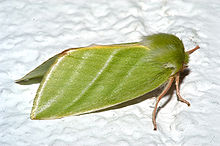Beech Kahneule
| Beech Kahneule | ||||||||||||
|---|---|---|---|---|---|---|---|---|---|---|---|---|

Beech Kahneule ( Pseudoips prasinana ) |
||||||||||||
| Systematics | ||||||||||||
|
||||||||||||
| Scientific name | ||||||||||||
| Pseudoips prasinana | ||||||||||||
| ( Linnaeus , 1758) |
The beech cahne owl ( Pseudoips prasinana ) is a butterfly ( moth ) from the subfamily of cahneulchen (Nolinae), which according to the more recent system is part of the owl butterfly family (Noctuidae).
features
The moths reach a wingspan of 30 to 35 millimeters. They have bright light green forewings on which two to three fine, indistinct, light transverse lines can be seen. In addition, there are parallel, adjacent, darker green colored lines. The wings of the males have a red, and the females a reddish-yellow edge. The hind wings of the males are yellow-green, those of the females are white. The legs, like the antennae , are red on the front, but white on the back. There are animals in which the inner edge of the wing and the transverse lines are colored red.
The caterpillars are about 35 millimeters long. They are also light green with many small, yellow spots and two narrow yellow vertical stripes. A slightly thicker yellow transverse band is visible behind the head. At the end of the abdomen, in front of the pusher , a short red line can be seen on each side. The four pairs of belly legs have significantly widened soles.
Similar species
- Great barnacle moth ( Bena bicolorana )
Occurrence
They come very near Europe and the rest of Palaearctic in deciduous forests before, especially in beech and oak forests widespread and numerous. They are absent in North Africa and the far north.
Way of life
The moths fly in the evening and at night and are attracted by artificial light. During the day you can find them sitting under leaves. In their resting position, the animals lay their wings together like a roof.
Flight and caterpillar times
The moths fly in one generation from early May to late July. The caterpillars are found from June to September. A second generation also flies in warmer regions until late summer.
Food of the caterpillars
The caterpillars feed on the leaves of deciduous trees and shrubs. They prefer European beech ( Fagus sylvatica ), sand birch ( Betula pendula ), English oak ( Quercus robur ), common hazel ( Corylus avellana ) and sweet chestnut ( Castanea sativa ).
development
The females lay the very flat, light yellow eggs, which are ribbed like wheels with spokes, individually on the upper side of the leaves of the forage plants. The caterpillars are also nocturnal. They pupate mostly on leaves in very tightly woven, whitish or light brown cocoons . With their keel on the front, these look very similar to a boat . The back of the doll is reddish-brown in color, while the underside is light yellow-brown. It overwinters before hatching in spring.
swell
Individual evidence
- ↑ Manfred Koch : We identify butterflies. Volume 3: Owls. 2nd, expanded edition. Neumann, Leipzig / Radebeul 1972, DNB 760072930 , p. 230f.
literature
- Heiko Bellmann : The new Kosmos butterfly guide. Butterflies, caterpillars and forage plants. Franckh-Kosmos, Stuttgart 2003, ISBN 3-440-09330-1 .
- Günter Ebert (Ed.): The Butterflies of Baden-Württemberg Volume 5, Moths III (Sesiidae, Arctiidae, Noctuidae). Ulmer Verlag Stuttgart 1997. ISBN 3-800-13481-0
Web links
- www.lepiforum.de
- www.schmetterling-raupe.de
- Ian Kimber: Guide to the moths of Great Britain and Ireland (English)
- Moths and Butterflies of Europe and North Africa (English)
- Pseudoips prasinana in Fauna Europaea

